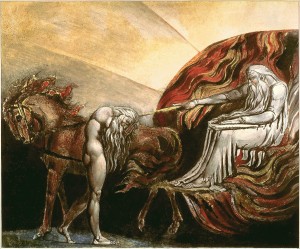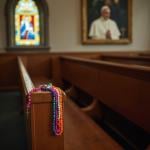
Source: Wikimedia Commons
We are now entering the Triduum, to celebrate the passion of Jesus Christ.
…celebrate…
How is it possible to celebrate the events leading up to his death on Golgotha, one of, if not the, most brutal tragedy in the history of man? For those of us who have had tough Lents, for whom certain realisations of their character or some phase of suffering have left them feeling very raw – for those of us in the Body of Christ that have had some share in Christ’s passion – this question can be more than academic. To our questions, the ancient theologians of the school of Alexandria, drawing heavily on the Gospel of John, respond by describing this moment as the time of Jesus’ glorification.
In what sense can we, reflecting on the brutality of the cross, at the same time become witnesses to the glorification of the man hanging on it?
A possible avenue would be a reflection on four tropes that are used to describe Jesus that converge in the event of the crucifixion: the Priest, the Lamb of God, the Bridegroom and the Second Adam. The Priest and Lamb motifs are obvious enough and often go together. Christ the True High Priest (using the author of the Letter to the Hebrews) offers Himself as the sacrificial Lamb and takes on the sins of many on the cross. Jesus, taking on that sin and experiencing the consequent separation from the Father, cries out in the words of Psalm 21: My God! My God! Why Have you forsaken me?
But what of the other two themes? How are they played out in the context of the Passion?
In chapter 9 of the Gospel of Matthew, Jesus portrays himself as a Bridegroom that will soon be taken away. Usually, we associate the being taken away with his being taken up into heaven, only marrying the Church at the wedding feast of the lamb at the conclusion Book of Revelation. But it makes no sense to have a bridegroom and not have a wedding on this side of the eschaton, until we remember that there was another, more intermediate and more terrestrial episode of the Bridegroom being taken away from his guests: namely the removal of Jesus from the company of his Disciples during the Passion. The eschatological wedding feast of the Lamb had already taken place within history in the form of the Last Supper. But where’s the wedding? And where’s the nuptial moment taking place? Scandal may probably set in at this point as the reader realises that this post hints at the crucifixion itself as the wedding and the consummation thereof. Is this association unjustified?
It is here that the third motif of Jesus as an Adamic figure – the Second Adam – comes into play. Paul’s first letter to the Corinthians makes a number of compelling parallels between Adam and Jesus, and these Adamic themes in the Scriptures have been continued on in the writings of Church Fathers like Justin Martyr, Irenaeus of Lyon and John Chrysostom. The Adamic theme in the Church Fathers is summarised in the fifth paragraph of Vatican II’s Constitution of the Sacred Liturgy Sacrosanctum Concilium. In the book of Genesis, as Adam slept, God created a woman out of his side who was to be his bride. In a new Genesical moment in John 19:34, as Jesus slept the sleep of death, God also caused a woman, the Church, to be created out of his side, a woman who is also to be the Bride of Christ.
But note also that in the Book of Genesis, the creation of the woman in 2:23 is immediately followed by a nuptial moment in 2:24, namely
For this reason a man will leave his father and mother and be united to his wife, and they will become one flesh.
The creation of the woman out of the side of Adam is at the same time a nuptial union between him with Eve. If Jesus the Second Adam was meant to complete in his humanity what was left incomplete in the first Adam, the only logical conclusion is that the crucifixion forms the privileged context in which the Second Adam marries the Church upon its creation from the side of the Bridegroom. Speaking of the Passion, John Chrysostom ended his Good Friday homily with the rhetorical question: Do you understand then, how Christ has united his Bride with Himself…?
The crucifixion is glorious because it is not only an execution, but also a wedding. It is glorious because Christ the Second Adam brings about on the cross a new Genesis, a new beginning. It is glorious because it is the starting point for the unfolding of a new Eden within history.
Finally, it is glorious because the cross is the fulcrum by which the old order is overturned. As such, we need not return to the old patterns of living. We are invited to envisage a world where, as Sunday ticks over into Monday, the lordship of these patterns in thinking and acting has come to an end. We are invited not only to envisage a new Genesis, but also a place for ourselves in this new Eden.
A blessed Pasch to all.















